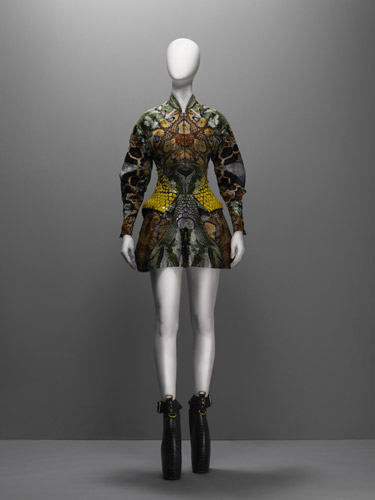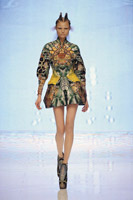Alexander McQueen (British, 1969–2010)
Dress
Plato’s Atlantis, spring/summer 2010
Silk jacquard in a snake pattern embroidered with yellow enamel paillettes in a honeycomb pattern
Courtesy of Alexander McQueen
Photograph © Sølve Sundsbø / Art + Commerce
Audio clip: Adobe Flash Player (version 9 or above) is required to play this audio clip. Download the latest version here. You also need to have JavaScript enabled in your browser.
Andrew Bolton: The exhibition ends with the collection Plato’s Atlantis, which was McQueen’s last collection while he was alive.
Sarah Burton: It was the idea of sort of the reversal of evolution, how life would evolve back into the water if the ice caps melted and we were being reclaimed by nature. We had all these engineered prints that he’d developed, sort of looking at the morphing of species, natural camouflages, and aerial views of the land.
We had research on the boards, and what he told us to do is he said, “I don’t want to look at any research. Turn all the boards around.” So he literally just worked from the fabric.
So what he would do is he would have an engineered print, and with that print he would place it on the form, and he would pin and construct these pieces that looked like they’d morphed out of the body themselves.
And only by taking the fabric and seeing how the fabric moved, you could come up with something new—by creating it on a body because clothes are to be worn; they’re not two-dimensional things. They are something that has to sit and mold onto a human being.
Andrew Bolton: The collection was streamed live over the Internet in an attempt to make fashion into an interactive dialogue with the audience. I think what’s particularly interesting is for the Romantics, nature was the primary vehicle for the Sublime, and for McQueen, technology was also a channel for the Sublime, particularly the extreme space/time compressions produced by the Internet.


 Vogue iPad app
Vogue iPad app
